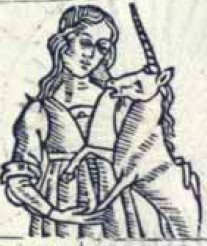http://www.third-millennium-library.com ... /2-25.html
Somebody (?) earlier mentioned the idea, that the word might might refer to a trunk of a tree .... as far I remember. Here we've a trunk, which is the logical center of some bound captives, connected to an Este heraldic symbol (unicorn) and the common triumphal chariot.The first evening the duke conducted his guests into the theater, and when they had taken their seats, Plautus appeared before the bridal couple and addressed some complimentary verses to them. After this the Epidicus was presented. Each act was followed by a ballet, and five beautiful moresche were given during the interludes of the play. First entered ten armed gladiators, who danced to the sound of tambourines; then followed a mimic battle between twelve people in different costumes; the third moresca was led by a young woman upon a car which was drawn by a unicorn, and upon it were several persons bound to the trunk of a tree, while seated under the bushes were four lute players. The young woman loosed the bonds of the captives, who immediately descended and danced while the lute players sang beautiful canzone—at least so says Gagnolo; the cultured Duchess of Mantua, however, wrote that the music was so doleful that it was scarcely worth listening to. Isabella, however, judging by her remarkable letters, was a severe critic, not only of the plays but of all the festivities. The fourth moresca was danced by ten Moors holding burning tapers in their mouths. In the fifth there were ten fantastically dressed men with feathers on their heads, and bearing lances with small lighted torches at their tips. On the conclusion of the Epidicus there was a performance by several jugglers.
If I interpret the chariot as a "(d'Este) Trionfi deck" (d'Este cause the unicorn), which naturally contains "captured" playing cards as long they're in their box or connected by another system (I think of the tackhole), which, if released, could cause a funny dance at the playing card table ... then this might be an allegory on Tarot cards.
If I assume, that a French use of the word "Taraux" (caused by the defeat at the river Taro) was known in Ferrara in February 1502, the foreign word naturally would have caused associations in the Italian language ... if the word for "Trunk of a tree" was similar (I don't remember, what it had been) ...
ah, I searched, here it was discussed
viewtopic.php?f=11&t=502&p=6857&hilit=trunk#p6857
"Tarato"
... then it might have inspired this dance and its show. Unluckily it's not said, how much prisoners made this dance. In the dance before the observer counted 12 dancers, perhaps one might conclude, that it must have been some more (too much to count for the observer). Perhaps there are better descriptions ...
The 4 lute players might present the 4 suits.






